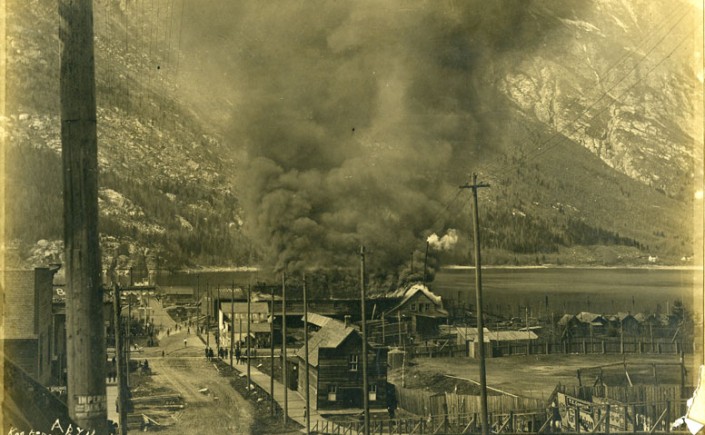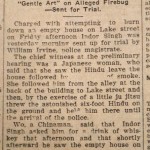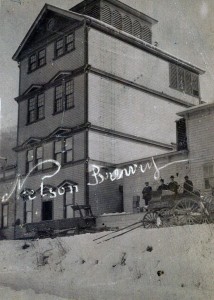PART ONE: 1911
The greatest danger facing any pioneer community in the BC interior was fire. In the twenty years since its beginnings as a mining camp in 1890, Nelson had escaped the fate of several other Kootenay towns. – Sandon in 1900 and Rossland in 1902, both severely damaged by fires. Hardest hit was Fernie which suffered three devastating fires, culminating in the 1908 conflagration which completely destroyed the city in only 90 minutes.
From Nelson’s earliest days, under the leadership of J. Fred Hume, a prominent merchant and MLA (1894 – 1898), concerned residents formed a volunteer fire brigade . Following incorporation in 1897, Mayor John Houston’s new city council enacted a by-law requiring all new construction in the downtown core to erect brick firewalls between buildings.
By the summer of 1911, the city had gone further than any of its neighbours, having created a professional fire department with the most up-to-date equipment and infrastructure available. With wagons and horse teams ready at a moment’s notice, they had a network of water mains and fire hydrants crisscrossing the city as well as a modern system of electrical call boxes scattered inside and outside the city limits – all connected to the Fire Hall at Victoria and Josephine – the site of the present day Kootenay Studio Arts.
Nevertheless, the wholesale district along the waterfront with its wood frame warehouses and lumber yards, the adjacent Chinatown and the Red Light District on Lake St , the retail stores and small houses of the working families, the hotels and boarding houses of the hundreds of single men in from the lumber camps and mines – all bone dry frame buildings jumbled together – the city was constantly in the brink of disaster – especially towards the end of a long, dry summer.
All this was cause for constant vigilance but not undue concern – until, in the last two weeks of August, 1911, it became apparent that the city had a firebug in its midst……
11 pm, Thursday, August 17, 1911.
A fire is spotted at the Yale Lumber yards and quickly extinguished. A fireman finds a discarded box of matches and a broken piece of candle.
August 18th
The next afternoon, on Lake St. a second fire is discovered and put out. Shortly afterwards Indar Singh is wrestled to the ground by a Japanese woman “using the silent art of jujitsu after he was seen leaving an alley. He claimed to have gone there to relieve himself.” He is placed under arrest.
August 19th
Another fire, beneath the wooden sidewalk only a block away.
August 20th
The basement of a house on Lake St.
August 21st
Between two houses near the corner of Lake and Hall.
August 22nd
Yet another incendiary attack against a residence on Lake St. occurred late last night, the sixth such attack since Thursday last. Although the blaze was quickly extinguished, it was identified as the work of the fire bug by several distinguishing features. The attacks took place in the neighbourhood of Hall and Lake Sts, occurred between 11pm and 1 am, and were started by placing a burning candle in a pile of shavings near a wall or fence – thereby allowing time for his escape before the alarm is given
August 23rd
A fire in the barn of a Chinese fruit ranch on Maple St is spotted by a streetcar conductor who gives the alarm.
FIRE BUG BURNS RANCH BUILDING The loss included a number of pigs which were roasted to death and some chickens. The heat and the glare of the flames seemed to have a fearful attraction for the birds and many of them, before they were reached by the flames, rushed into the blaze and shrivelled up before the eyes of the bystanders. The owner of the ranch said he did not think he could save a quarter of the crop stored there and that he had no insurance. Damage was estimated at $5,000. – NDN
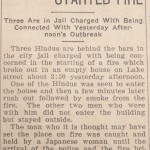 The talk around town was that the attacks were racially motivated – someone had it in for the Chinese or for businesses that employed foreign labour like the Yale Columbia Lumber Company. Of course, that described most of the people in Nelson. The way they saw it, the Chinese and East Indians were willing to work for practically nothing which helped the bosses keep wages down and bust the unions. As a matter of fact, they thought the Italians were just as bad. However, that theory, and the complacency that went with it, flew right out the window the very next night.
The talk around town was that the attacks were racially motivated – someone had it in for the Chinese or for businesses that employed foreign labour like the Yale Columbia Lumber Company. Of course, that described most of the people in Nelson. The way they saw it, the Chinese and East Indians were willing to work for practically nothing which helped the bosses keep wages down and bust the unions. As a matter of fact, they thought the Italians were just as bad. However, that theory, and the complacency that went with it, flew right out the window the very next night.
August 23rd
ATTEMPT MADE TO BURN FIREHALL A tool shed beside the hall was destroyed causing $750 damage.
August 25th
FIRE BUG ATTACKS CITY HALL A fence beside the building was set alight. A dark figure was seen fleeing the scene.
August 30th
Fire Discovered in Lumber Yard on Vernon St
FIRE BUG STILL IN NELSON “That the fire was of incendiary origin appears to be certain and the police are still keeping a look out for suspicious characters. Their work is being supplemented by a number of special watchmen hired by the city and individuals.”
August 31st
After a preliminary hearing at which Police Chief C.W. Young was called for the defense, Indar Singh, who had been sitting in jail during the previous two weeks, was finally released.
By this time there had been a score of false alarms and over a dozen fires, including two which were clearly not arson, a chimney fire and, on the 29th, a smoldering cigar butt which attracted a crowd of two hundred Chinese outside a restaurant on Hall St.
Night after night hired watchmen and self-appointed vigilantes patrolled the dark streets and alleys as searchlights from the steamers tied up along the waterfront swept back and forth searching for a glimpse of the sinister figure of the fire bug – a figure so clearly etched in their imaginations yet never once clearly seen. On one occasion, Special Constable Robert C. Brand was showing off his pistol – which he claimed wasn’t loaded – to Mr Chou, a café owner, when it went off hitting the latter in the leg…..
Some enthusiastic civilians are making a practice of carrying guns. This must be stopped at once. If anyone is found down there with a gun in his possession he shall be summoned for carrying a concealed weapon. It is absolutely necessary for the safety of the public that no one but the police is armed.
– C. W. Young, Chief of Police.
Night after sleepless night nervous citizens went to their beds after observing their rituals of precaution – sticks and broken bottles strewn along pathways, bells and tin cans stretched across gates and fences, ropes tied to beds and hung from second story windows. Where will he strike next? Will I smell the smoke, hear the crackle of the flames in time? Or will exhaustion force me to sleep at last, never to wake again……
September 1st, 1911
An alley above Latimer St behind the Nelson Brewery, ironically just up the street from the site recently chosen for the new Fire Hall. There are no patrols this far up the hill, here among the respectable houses where the fire bug has never struck before. For fifteen, twenty minutes the flames go undetected until the entire back wall of the building is a sheet of flame. Finally, from a house across the way, Miss Gigot, notices the red glare through her parlour window….. Fire! Fire!
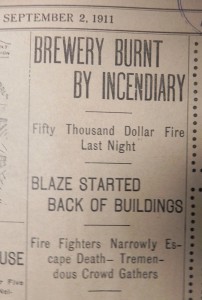 The twenty year old, four story building is built almost entirely of wood, and now, after weeks of perfect, cloudless summer weather, is as dry as a stack of kindling. Within minutes of the alarm being given, every hose and wagon in town is on the scene – but it’s too late. They never had a chance…. With a skyward rush of air and a roar that was heard on Baker St., the flames race up the timbered walls and into the red sky. Huge beams crack and crash beneath the weight of machinery, glowing, twisted metal plunging into the heart of the flames, billowing clouds of steam rolling through broken windows and doorways as the brewery vats split open and hundreds of gallons of beer flowed ineffectually into the fire.
The twenty year old, four story building is built almost entirely of wood, and now, after weeks of perfect, cloudless summer weather, is as dry as a stack of kindling. Within minutes of the alarm being given, every hose and wagon in town is on the scene – but it’s too late. They never had a chance…. With a skyward rush of air and a roar that was heard on Baker St., the flames race up the timbered walls and into the red sky. Huge beams crack and crash beneath the weight of machinery, glowing, twisted metal plunging into the heart of the flames, billowing clouds of steam rolling through broken windows and doorways as the brewery vats split open and hundreds of gallons of beer flowed ineffectually into the fire.
The fire raged on and the flames leapt ever higher into the night sky, drawing the largest crowd that had ever witnessed a blaze in the city. Rushing from their beds and onto the street in the scantiest of light attire, some of the women from nearby residences were terror stricken and a few were hysterical.
Blazing fragments of wood which were flying in all directions proved the source of the greatest danger to residents on all sides of the brewery. That a general conflagration did not ensue was due to the fact that there was little wind and to the efforts of citizens who, perched on their rooftops through the night soused their houses with water from buckets and small hoses.
And somewhere in the crowd, leaning against a tree perhaps, arms folded – or commiserating with a neighbour and shaking his head at the senseless waste of it all – the fire bug watched. What was he thinking? What inextinguishable fire burned inside him? Would this be enough to satisfy it? And for how long?…….
September 2nd
While the smoke and steam from the brewery fire still drifted gently over Latimer St., two watchmen nervously patroled the deserted yards and buildings of the Hall Mines smelter which looked down on the city from a bluff less than a mile away across Cottonwood Creek. One of them had spotted a fire there that afternoon.
Falling silver prices had shut the smelter down for five years but just the week before a syndicate of businessmen had finalized a $200,000 deal to reopen it. It meant work for a lot of people and the real prospect of Nelson replacing Trail as the smelting centre of the Kootenays.
COLOSSAL BLAZE STARTED BY FIRE BUG DESTROYS SMELTER By 2 o’clock Sunday morning practically nothing was left of the three furnaces, the aerial tramway terminus, the vast ore bins, a network of small tramway lines and innumerable accessories but a heap of red hot iron, bricks and smoldering woodwork, above which rose in lonely grandeur, the great smokestack, 187 feet high.
So tremendous was the fire that the flames lighted up the whole city so brightly that it was possible to read small print on the streets many blocks away. The mountains on all sides showed up clearly in the weird red light and passengers on the incoming train from the coast saw the blaze reflected blood red in the sky many miles away. From points in all directions came telegraphic messages asking if the entire city were going up in smoke.
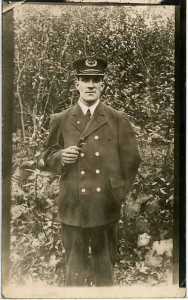
Though unverified, this postcard probably shows Chief Guthrie, whose leadership and professional fire department saved Nelson from destruction at the hands of the Fire Bug.
As Monday dawned, Nelson was in a panic. Where would he strike next? Despite the valiant efforts of the fire brigade was it not merely a matter of time before the right combination of fire, wind and bad luck reduced the city to ashes – as had happened to Fernie just three years before?
During the day leading up to a public meeting called for that evening, the flames of fear, fuelled by fanciful tales and wild rumours raced up and down the streets…..They say there was dynamite stored in that shed beside the fire hall – the one they got to just in time…..He’s a mad man determined to destroy us. He went after the Yale Columbia again last night! It’ll be the schools and churches next…..He’s going after the churches now! Take a look at the Presbyterian. It’s as dry as kindling……I heard there was a pile of kindling found at the Presbyterian Church…..Well I heard the mayor got a letter from him yesterday giving a list of the places he means to attack. He said he plans to escape by moonlight. And blame was being spread around with equal liberality – it was the Catholics, the Protestants….It was the Chinese themselves involved in some kind of gang warfare!
At that evening’s meeting Mayor Harold Selous declared, “Yesterday I sent the following telegram to the provincial Attorney General, the Honourable Mr. Bowser. ‘Incendiary fires have occurred almost nightly since August 17, both inside and outside our city limits. Last night Hall Mines smelter burnt outside limits. Loss $200,000. Local police unable to cope with situation. Citizens completely panic stricken and appeal to you to send superintendent of provincial police and force of detectives to take whole situation in charge.’ The city is also posting a reward of $500 for information leading to the capture and conviction of the fire bug!”
Over the next week, two weeks, the city held its breath. Night followed night with no new attacks. Gradually people began to relax. Maybe the worst was over. The fire bug was satisfied at last. He’s left town. Fear of capture had won out over his mania…
September 10th
The police arrested a dapper, 24 year old Englishman, John Bradshaw, on a charge of vagrancy.
During questioning it was established that Bradshaw had been in the Kootenays – either in Nelson or working in lumber and mining camps – for the past two years. He expressed resentment against Asians who were taking jobs from white men. He was also identified as the man who gave the alarm at the Chinese fruit ranch on August 23rd and had been spotted at several other fires. But all this was very flimsy and circumstantial evidence so eight days later Bradshaw was released and advised to leave town.
Which he did. And interestingly, there were no more arson attacks for the rest of the year……
Note: There are no photographs of fires caused by or attributed to the Nelson Fire Bug. The photo at the top of the page is of the Sash and Door Factory fire on Nelson’s waterfront, April 16, 1903 and is as close as we can get.
